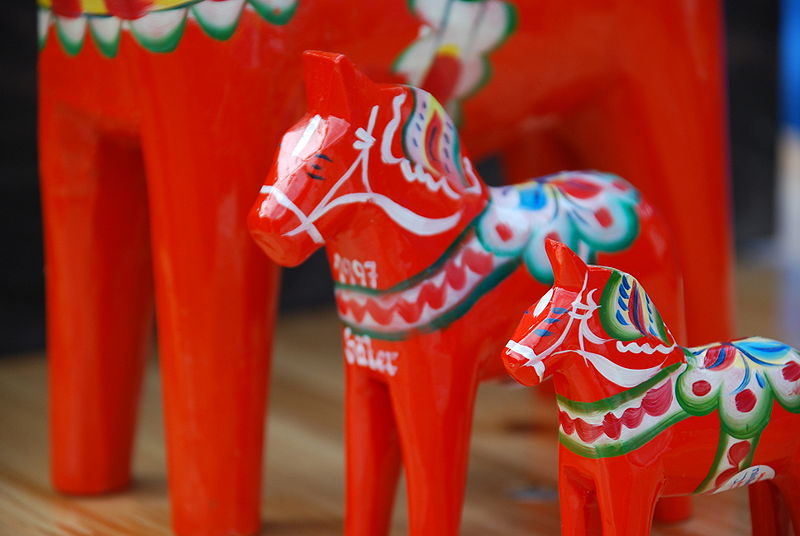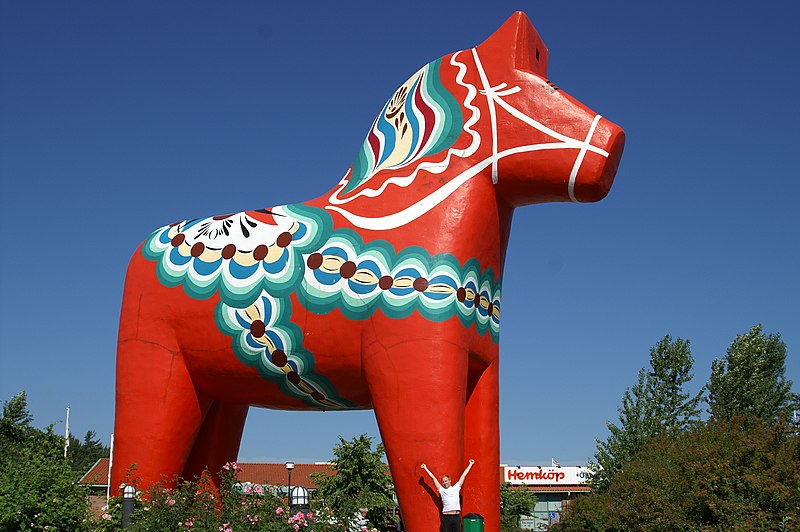by Susanne Dietze
Once a toy, the carved, painted wooden Dala Horse, also known as a Dalecarlian horse or Dalahäst, has become a symbol of Sweden, as well as Dalarna, the province from which it originated.
 |
| Dalecarlian horses in three different sizes. Public Domain. |
It isn't known precisely when Swedes first started carving Dala Horses as toys for their children, but they have been around for centuries, most likely fashioned from wood scraps from furniture making, the local industry. Legend says they became the national toy in the winter of 1716, a time of war. Soldiers were quartered in private homes in the Mora area of Sweden, and families and soldiers alike suffered from the severity of the winter. Food was scarce.
According to the legend, a soldier boarding with a family carved a Dala Horse from scrap wood and painted it bright red, a color which was available due to pigments produced from a nearby copper mine. He painted a harness and saddle onto the horse in the kurbits style, which is a decorative motif referencing the kurbit plant which shaded Jonah as he waited outside Ninevah for the city to receive its judgment.
The soldier gave the toy to the household's child, and in return, the mother provided him a bowl of soup. He crafted another horse and received more soup, and his fellow soldiers took to carving horses to barter for food, as well.
 |
| Dala Horse from around 1950. Public Domain. |
Others insist the wooden horses are relics of pre-Christian paganism in Scandinavia, and note that some Viking graves contain small wooden horses. Later, it's suggested wooden horses were tied to witchcraft.
However Dala Horses were first crafted and used, however, in the eighteenth century, the making and enjoying of small horses grew in popularity. Children carved them as well as adults. Eventually, Dala Horses came to stand as representatives for Swedish culture, handicrafts and for the country itself.
While popular in Sweden, the horses were little known in America until the World Exhibition of 1939 in New York. A 2.5 meter Dala Horse stood sentry outside the Swedish pavilion, and visitors loved it. In the following year, 20,000 Dala Horses were shipped to New York.
While most often seen as bright, orange-red toys (or even as statues in town squares), they are also painted blue, white, black, or other colors, and are sometimes left plain. Swedish store Ikea even sells black-and-white versions.
 |
| Huge dalecarlian horse near Avesta (Dalarna). Public Domain. |
While some are now mass-produced, Dala Horses are most often crafted of pine, hand-carved, so no two horses are identical in size or shape. Some aficionados consider the only authentic Dala Horses to be those originating in the Dalarna village of Nusnäs, where a quarter million horses are made each year.
They are considered must-have souvenirs for those visiting Sweden, and today, they can be found in homes across the globe.
***
 GIVEAWAY: I incorporated a special Dala Horse in my newly released story, Love in Any Language, part of the Barbour Collection Lessons on Love. If you'd like to win a copy, let me know in the comments. I'll randomly pick a winner tomorrow, Oct 4, 2019, at 9 am pacific time. Void where prohibited.
GIVEAWAY: I incorporated a special Dala Horse in my newly released story, Love in Any Language, part of the Barbour Collection Lessons on Love. If you'd like to win a copy, let me know in the comments. I'll randomly pick a winner tomorrow, Oct 4, 2019, at 9 am pacific time. Void where prohibited.
***
RITA-nominated Susanne Dietze is an award winning, bestselling author. You can learn more about her and the story on her website, www.susannedietze.com.



Fascinating post! I've seen this little horses, but never knew they had such a rich history. Thanks for sharing. I'd love to be entered into the drawing for your book.
ReplyDeleteHi Linda! I'm glad you enjoyed the post.
DeleteYou're entered into the drawing!
Thanks for the post! I love the history/legend behind these little treasures! I have the book so if I win, please draw another name! Thanks for the giveaway.
ReplyDeleteI'm glad you came by and said hi! Aren't the dala horses lovely? Have a great day, Connie!
DeleteThanks for this post! I have a little one of these horses but never knew the history behind them. Very interesting! And thank you for the giveaway!
ReplyDeleteDo you remember how you got the horse, Linda? Was it a gift or something you picked up along the way? Last year they were selling at World Market in their Scandinavian Christmas line. I bought some ornaments!
DeleteYou're entered into the drawing!
I got the horse at Al Johnson's restaurant in Sister Bay, Wisconsin (in the Door County peninsula.)It's been around a long time, I remember going there when I was a kid, always to get Swedish pancakes,meatballs, and lingonberries. They have a large gift shop with lots of beautiful things from Sweden, including many sizes of the dala horses!
DeleteOh, how wonderful! (The food sounds wonderful, too!)
DeleteI would very much like to win a copy of this book, thank you for the chance.
ReplyDeletewfnren at aol dot com
Hi Wendy! You're entered into the drawing! Hope your day is going well.
DeleteCongratulations to you, Wendy! You won the book. I'll be in touch!
DeleteWhen I researched my book No Neutral Ground, I discovered Dala Horses and included them in my novel. I even bought a pair on eBay. I hadn't heard the story of them originating with a boarding soldier. Please enter me in your giveaway.
ReplyDeleteHi Terri! I will have to look up your book! I, too, have a Dala horse now. They're really special, aren't they? :)
DeleteYou're entered into the drawing!
I've always loved horses, so this post really caught my eye. I'm not sure why, but I never associated horses with Sweden. I do like their national symbol though. Interesting post!
ReplyDeleteSo glad you enjoyed the post, Vickie! Have a great day!
DeleteWhen in Sweden I bought two small horses which go on my Christmas tree each year. They remind me of my maternal grandparents, both born in Sweden and came here in 1910.
ReplyDeleteThat's really wonderful!
DeleteOh, that's lovely, Stacy! What treasures!
DeleteI bought a few small Dala horse ornaments last year at World Market. They were part of their Scandinavian Christmas line and impossible to resist. My family isn't Swedish (the Danish part of me is pretty close, though!) but I love the Dala horses. Thanks for sharing!
Hi Deb! Thanks for coming by! <3
DeleteI love these little horses; how neat to learn about their history! I would love to win a copy of "Lessons on Love"! Thank you for the giveaway!
ReplyDeleteHi Sarah! You're entered into the drawing.
DeleteI'm glad you enjoyed the post!
Susie, thank you for sharing this fascinating post! I adore horses.
ReplyDeletepsalm103and138atgmaildotcom
Hi Caryl! So glad you could come by! You're entered into the drawing. Thanks for stopping in!
DeleteI love these horses. I saw some small ones at a shop that carried things from foreign countries but had no idea of their history. Next time I see one, I'll have to get it. Thanks for a fun post.
ReplyDeleteHow wonderful, Martha! I truly enjoyed learning about them, too. You'll have to let me know when you get one! So glad you enjoyed the post.
DeleteI would love to win a copy of "Lessons on Love"! Thanks for the giveaway!
ReplyDeleteI'm so glad you could drop in and say hi! You're entered into the drawing.
DeleteI live in Lindsborg, Kansas, known as "Little Sweden, USA." Dala horses are very common here. In fact there is a "herd of wild Dala horses" around our town. Swedish traditions are valued and celebrated. In a few weeks we will have Svensk Hyllningsfest, which is celebrated every other year.Our 1st-8th graders are busy practicing the traditional dances, which will be performed in traditional costumes. There are also teen and adult Swedish dancers. I'll include a link for anyone who is interested: https://www.visitlindsborg.com/wild-dala-horses. It's a great little town in central Kansas.
ReplyDeletepmkellogg56[at]gmail[dot]com
Oh Pam, yes! I've heard of Lindsborg, but not the Svensk Hyllningfest! Thank you so much for including the link. I will go check it out.
DeleteYou are included into the drawing!
I enjoyed learning the history of the Dala horses, especially since I wondered about their significance whenever I saw one. Thank you for the giveaway, Suzanne; I would love to win "Lessons on Love."
ReplyDeleteI loved learning about the horses, too, Roxanne! They have such a rich, lovely history!
DeleteYou're entered into the drawing!
My brothers and I have Dala horses from my grandfather who came from Sweden. They are very special to us.
ReplyDeleteWhat a treasure! I imagine those are precious heirlooms!
DeleteThank you so much for dropping by. You're entered into the drawing!
Congratulations to Wendy N who won the book! Thanks to everyone who dropped by and entered to win.
ReplyDeleteCongrats on your new release, Susie. I'm looking forward to reading your story and love that you've used a Dala horse.
ReplyDelete